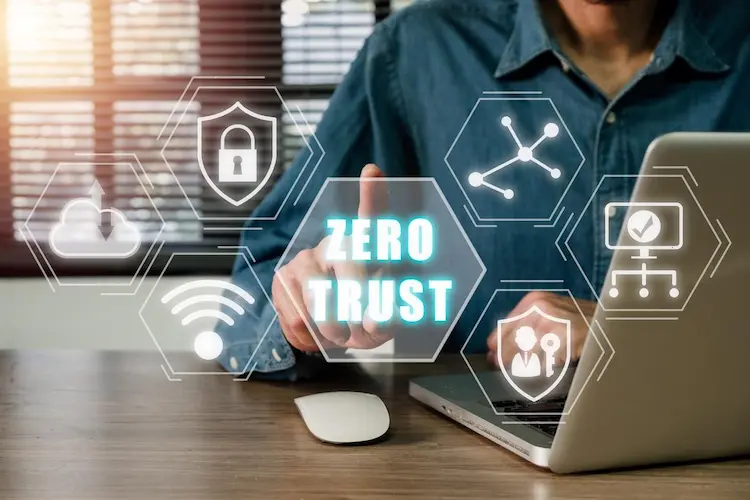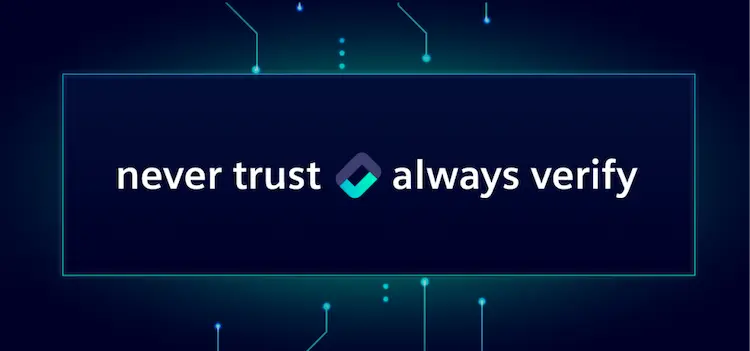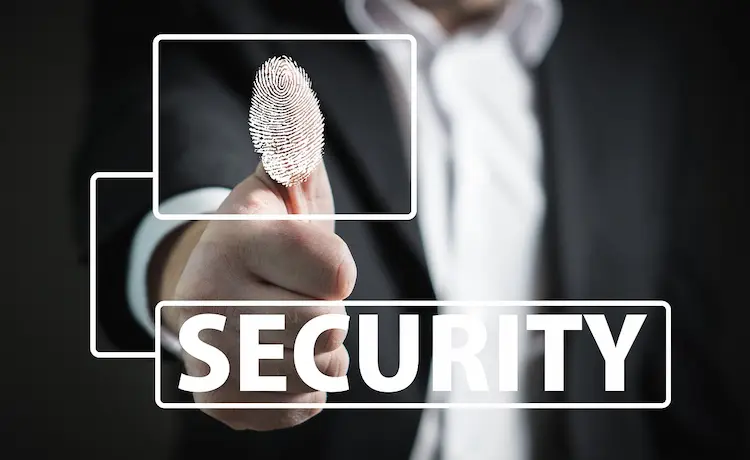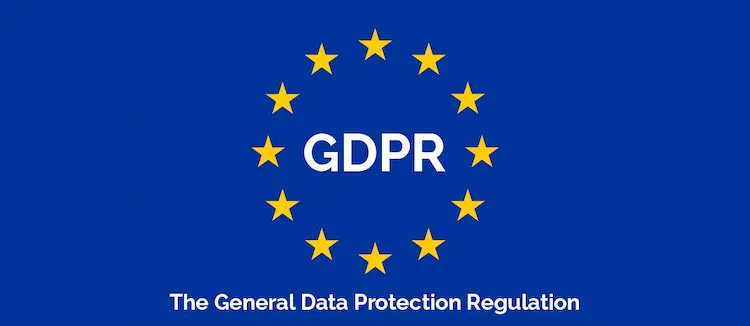Cybersecurity threats are becoming increasingly sophisticated. This creates a demand for innovative defense solutions. Traditional methods such as firewalls and intrusion detection systems are struggling to keep up with the complexity of modern cyber-attacks, which can bypass these defenses.
This growing threat can be tackled by using the zero trust security model, which operates on the principle of ‘never trust, always verify’. Previously, anyone or anything already inside the network was considered safe and required little or no verification, but with zero trust, checks are carried out frequently. Using this security model ensures a more proactive approach to safeguarding digital assets and information.
Understanding the Zero Trust Security Model

With complex digital threats becoming more advanced, it’s beneficial to have a strong understanding of zero trust security models and the education to back this up. An online Master’s Cybersecurity qualification from a reputable educator, such as St. Bonaventure University, offers a comprehensive curriculum that aligns with the zero trust model’s principles.
St. Bonaventure University’s program covers contemporary cyber defense strategies, such as ethical hacking, preparing graduates to design and implement strong security systems. Obtaining a qualification can help professionals to stay ahead in the rapidly evolving cybersecurity industry.
The zero trust security model is a strategic approach to tackling modern threats to cybersecurity. It eliminates the idea of continuous trust in an organization’s network architecture. Rather than being a single technology, zero trust is a proactive approach to network security, incorporating various defensive elements.
Its core philosophy challenges the idea that everything inside an organization’s network should be automatically trusted once it has been verified. Instead, organizations using zero trust recognize that most things can be breached or corrupted. They use this model because it treats all users and devices, both inside and outside the network, with the same level of skepticism and subjects them to verification measures.
Cloud computing, the rise of remote working, and more people using mobile devices for work have all contributed to its increased use. For example, financial institutions, such as banks, have made the shift to cloud-based storage. This allows them to store and easily access sensitive data and run important applications. However, the rise of internal threats, such as insider attacks and lateral movement of attackers within a network, has further highlighted the limitations of perimeter-based security models.
By adopting zero trust, these businesses can protect their assets and ensure that only approved users can access information and programs. As a result, organizations have a higher level of protection against anyone who shouldn’t be accessing the system.
The Principles of Zero Trust
The zero trust model is a more advanced approach to cybersecurity compared to traditional security models. It’s built on a set of foundational principles that collectively enhance an organization’s security.
‘Never trust, always verify’

‘Never trust, always verify’ scraps the old idea of verifying once, and then trusting indefinitely. Previously, an employee might enter a password or use one or more different methods to verify their identity. Then the system would offer the option to store their details for future visits. This practice saves just a few seconds for the user but makes it easier for non-authorized people to get into the system.
In contrast, a zero trust approach requires authorized individuals to verify themselves on each visit. This happens regardless of where they are in the network. This principle sees trust as a vulnerability, accepting that once inside the network, it’s possible for users, whether they have malicious intentions or not, to have too much access.
Least privilege access
The principle of least privilege access ensures that users have the precise access they need to perform their job functions. This method of risk management reduces the number of entry points for an attacker either outside or within an organization. It does this by limiting user access rights and permissions to the minimum necessary to perform their duties.
In a zero trust framework, users are granted just enough access, but no more, reducing the potential for internal and external breaches. This principle also involves continuous assessment of user roles and privileges, which can change in today’s fast-moving organizations. It then adjusts permissions as requirements change.
Micro-segmentation
Another principle of zero trust is using micro-segmentation. This is the process of dividing the security perimeter into smaller, distinct zones to maintain separate access for different parts of the network.
In a zero trust model, micro-segmentation is an important part of containing breaches and minimizing the movement of any attackers who find a way into the network. By segmenting networks and data, organizations are prepared for more advanced threats that they were previously unaware of. They can limit a cybercriminal’s ability to move across the network. This approach also enables more effective monitoring and isolation of network segments, which can be critical in reducing the impact of an attack.
Continuous monitoring and validation
The principle of continuous monitoring and validation is an ongoing process. This involves scrutinizing network activities, and real-time validation of security configuration. Continuous monitoring implies that the organization is always watching and analyzing the network for unusual behavior that could signal a breach. This may sound invasive for employees, but it’s important to note that rather than spying on people who should be there, it monitors patterns. This principle ensures that any deviations from normal patterns are quickly detected, investigated, and dealt with. It’s crucial for identifying and quickly responding to threats.
Multi-factor authentication
Multi-factor authentication (MFA) is another principle of the zero trust model. Users are asked to provide at least two methods of verification to be allowed access to a resource. This can be a network, application, or database. The verification will be something they know, such as a password; something they have, such as a smartphone; or something unique to them, such as a fingerprint.
MFA adds a layer of security, ensuring that if one factor is compromised, unauthorized users still cannot gain access. This makes it easier for the authorized person to gain the access they need, but less likely for non-authorized individuals or groups to be allowed inside the system. For organizations wanting high security without slowing down their operations, this is vital.
Implementing Zero Trust in an Organization

Implementing a zero trust model in an organization is an extensive process that involves a significant change in your approach to cybersecurity. It’s not just about using new technology – it also involves adopting a new mindset. You will need a step-by-step strategy for effective implementation.
What needs to be protected?
The first step involves identifying what needs to be protected. This includes sensitive data, critical assets, systems, and applications. Organizations should understand where their valuable data is stored, how it’s used, and who has access to it. This helps to define the scope of the zero trust implementation. It involves data classification and asset management to establish a clear understanding of the organization’s most important information.
How are data and assets accessed?
Recognizing how data and assets are accessed and by whom is an essential part of this. Mapping the transaction flows involves analyzing how information moves within and outside the organization. This step helps in understanding communication pathways and data transfer patterns. It is crucial for identifying legitimate access scenarios and establishing the baseline for normal network behavior. This information helps with the design of a zero trust model that supports necessary business operations at the same time as minimizing risks.
Design a zero trust network
Once you have a clear understanding of what needs protection and how data flows, the next step is to design a zero trust network. As mentioned, this involves applying micro-segmentation to create secure zones, deploying firewalls and intrusion prevention systems, and establishing secure access controls. Network architecture must be reconfigured to ensure that no user or device has inherent trust. This step often involves significant changes in the network infrastructure and requires careful planning to avoid disruption to business operations.
A zero trust policy forms the rulebook for network operations. It defines how security controls are enforced and how users and devices are authenticated and authorized. The policy should be adaptive, and capable of adjusting to evolving threats and changing business needs. It should include guidelines for continuous monitoring, how to respond to specific incidents and user behavior analytics.
Once implemented, the zero trust model will need ongoing management and maintenance. Continuous monitoring is vital to this approach, as the security status of users and devices must be regularly assessed. Alternatively, if an employee leaves, they no longer have the need or a valid reason to access the system.
The use of automated tools and AI for real-time threat detection and response is essential. This ensures that people can focus more of their attention on their specific jobs, rather than having to constantly monitor threats themselves. However, people are still important in this equation. Regular audits and policy updates are necessary to ensure that the zero trust framework remains effective and aligned with the organization and its development.
The Challenges of Implementing the Zero Trust Model
Transitioning to zero trust can present several challenges. One main challenge is the cultural shift required within the organization. Employees and management need to have an understanding of the zero trust philosophy. Training and awareness are an essential part of this.
Another challenge is the complexity involved in redesigning the network and using new technologies. This may require financial investment and expertise. Partnering with experienced vendors and consultants is one way to overcome this challenge.
Balancing security with user experience is also important. Overly stringent controls can reduce productivity. Therefore, it’s important to implement zero trust in a way that supports business agility while maintaining security. Some of the methods mentioned earlier, such as using fingerprints and personal mobile devices, can help to tackle this. These are easy for authorized users to access and use but make it much more difficult for non-authorized users.

The Benefits of Zero Trust for an Organization’s Cybersecurity
The zero trust model transforms an organization’s cybersecurity. The model has several benefits, including the following.
Tackling unexpected threats
One benefit is that organizations are now adaptable to threats, even those they were unaware of. Businesses, particularly those that aren’t in the tech industry, can be unaware of the new tactics that hackers will try. By adopting the ‘never trust, always verify’ principle, they don’t have to be tech experts.
Constant verification reduces the risks, and micro-segmentation lowers the impact of any successful attempts to access the system from those who shouldn’t be there. This leaves the business and its employees free to focus on other tasks. Any unusual activities will still be quickly detected and dealt with.
Following data protection laws
In an age when data protection and privacy are paramount, zero trust helps organizations follow various compliance and regulatory requirements. Many data protection laws, such as the GDPR and HIPAA, have strict rules over access to sensitive information.
This model, with its core principles, supports compliance with these regulations. It provides a strong framework for managing and protecting sensitive data, ensuring that organizations can meet their legal and ethical obligations for data security.

Data categorization
Zero trust helps organizations manage and understand their data better. It does this by making them identify and categorize all their data and assets. This clear view is important for effectively managing data. By being aware of who is accessing what data and how they are behaving, organizations can quickly notice and react to any unusual activities.
Scalable and adaptable
The flexible nature of the zero trust model makes it highly scalable and adaptable to various organizational changes and evolving threats. As organizations grow and their network environments become more complex, the design can be adapted to include new users, devices, and applications without compromising security. This scalability is crucial with the constant changes of today’s technology and the demands on businesses, making it necessary to adapt quickly to stay competitive.
The future of zero trust
The zero trust security model’s foundational principle of ‘never trust, always verify’ is fast becoming the standard in organizational cybersecurity. Looking ahead, the integration of emerging technologies and their wider use across various sectors seems likely to continue.
AI and machine learning
AI and machine learning are set to play a bigger role in the evolution of zero trust. These technologies can analyze large amounts of data to detect anomalies and potential threats. Alongside professionals who program and help to interpret findings, this improves security systems.
AI-driven zero trust systems can continuously learn and adapt to new threats, automating real-time decision-making processes for access control and threat detection. This leaves more time for employees and management to focus on other aspects of the business.
Blockchain technology
Blockchain technology is known for its strong security and decentralized setup. It can improve zero trust systems by offering a clear and unchangeable record of who is accessing the network and any changes made to it. This integration can bring an added layer of security and accountability, making it harder for attackers to tamper with or cover their tracks.

Wider use of zero trust
Zero trust is expected to become more widely used across various industries because of its effectiveness in reducing modern cyber threats. More sectors now handle sensitive data, including healthcare, finance, and government.
As its implementation becomes more prevalent, it will also be tailored to different industries. Customization of the model’s frameworks to suit specific industry needs will likely become more common. For example, the financial sector might integrate advanced fraud detection mechanisms: this is less of a priority in industries such as healthcare, which are more likely to focus on protecting patient data in compliance with HIPAA regulations.
If the increasing rate of cyber-attacks and data breach attempts continues, this may prompt regulators to mandate zero trust models in certain industries. This regulatory push would significantly fast-track the adoption and standardization of zero trust security practices.
IoT and edge computing
As the Internet of Things (IoT) and edge computing keep growing, the demand to secure the many devices and the data they create will increase. The design will need to evolve to address less secure environments. This is to ensure that security goes beyond the usual limits of the network.
User experience
While security is a priority for organizations, the future of zero trust will also involve balancing security measures with user experience. Solutions that offer seamless verification processes and minimal disruption to users’ workflows will always be key to successful implementation and user acceptance.
The Imperative of Zero Trust in Safeguarding Organizations
In modern cybersecurity, zero trust addresses the sophisticated and evolving nature of cyber threats. Its principles of continuous monitoring and least privilege access greatly enhance an organization’s defense against both internal and external threats. This approach maximizes security in today’s digital age of complex, interconnected systems.
The journey toward implementing this model signifies a proactive step toward a more secure digital environment. It demands commitment and adaptation but promises a resilient cybersecurity stance in an increasingly technology-driven world.